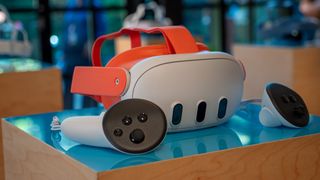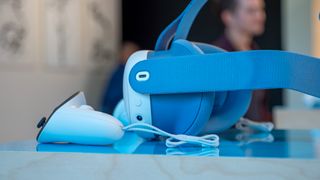Meta Quest 3: Everything you need to know
Don't call it a VR headset. Meta has designed the Quest 3 with mixed-reality in mind, for 1/7 the price of Apple Vision Pro.

To some, the Meta Quest 3 is the best VR headset available, hitting the right balance between next-gen tech upgrades and affordable compromises. To others, it's too expensive compared to the Quest 2 or not powerful enough against the premium Apple Vision Pro.
We've followed the Quest 3 closely since its late 2023 launch, tracking all of its updates, new games, and controversies. Aside from sharing all the specs and comparisons to other headsets, we'll share everything that new Quest 3 owners or prospective buyers should know about the headset.
If you want a more personal breakdown of what it's like to use the Quest 3, you can read our Meta Quest 3 review for all the highs and lows. In particular, we praised the upgraded mixed-reality passthrough in full color, the more ergonomic controllers, and the revamped graphical power, while noting some design issues and poor battery life.
Below, we'll focus instead on all of the raw numbers, prices, accessories, and so on, to help you decide if it's worth upgrading to the new headset.
Meta Quest 3: Price and availability
The Meta Quest 3 became publicly available on October 10, 2023. The base 128GB Quest 3 costs $499 / £479 / €549, while the 512GB model is $649 / £619 / €699.
Aside from storage, you won't find any other differences, except that all 512GB Quest 3 buyers get six months of free Meta Quest Plus, an $8/month subscription that gives you two Quest games for free, as chosen by Meta.
We have a guide comparing the 128GB vs. 512GB Quest 3 that breaks down the decision. To summarize it briefly, most Quest 3 games measure about 2–3GB in size, but major releases can swell up to 10GB or more — especially with post-launch updates and DLC. 512GB is more than most people need, but if you choose the default 128GB model, you may have to delete games to make space.
Thankfully, Quest games support cloud storage, so if you do choose the 128GB Quest 3, you can make space in your library and redownload games later.
Meta Quest 3 design and display

The most visible change to the Meta Quest 3 stems from its pancake lenses, which take up less space than the Quest 2's fresnel lenses by magnifying through thin, reflective mirrors instead of one thick layer. This makes the Quest 3 headset 40% skinnier in front.
Despite being skinnier, the Quest 3 weighs slightly more than the Quest 2, which Meta itself attributes to new components like the depth sensor, extra cameras, and depth adjuster. Thankfully, the weight distribution is much more balanced, meaning it's not all resting on your forehead and slowly creating pressure.
It's still going to feel heavy after a while, though. Like the Quest 2, the Quest 3 ships with a cloth strap with velcro to adjust the fit, instead of the built-in Elite Strap with rear padding and adjustment knob you get on the Quest Pro.
Unlike the single Quest 2 strap, which could slide to one side of your head, the Quest 3 uses a split overhead strap design that gives you better support but "rubs on the top of your ears," according to our reviewer.
That's why we called a Quest 3 strap replacement the "one accessory you actually need." It provides a more comfortable and secure fit, and you can even buy a strap with a built-in battery to improve the Quest 3's longevity. Since the Quest 3 has a modular design, installing a new strap should only take you a few minutes and doesn't require any expertise.

A subtle but vital upgrade from the Quest 2 is how you can change how close or far the lenses sit from your eyes, a function built into the facial interface. You'll choose between four options, with the furthest setting leaving enough room for you to wear glasses without a spacer.
Plus, there's the underrated perk that the full-color mixed-reality means you have fewer reasons to take off the headset and worry about adjusting the fit. You can simply double-tap the side to leave your game, see your surroundings, and resolve whatever real-world issue is happening.
Our one frustration with the new Quest 3 facial design is the lack of venting, which can cause the lenses to fog up from your face's heat. That's why you may want to buy a new facial interface that allows for better air circulation.
Moving on to the Meta Quest 3 display, it uses an LCD, a cost-saving measure that'll make its colors less vibrant than the PSVR 2's OLED. Putting that aside, though, it's still a significant visual upgrade over the Quest 2: 2064 x 2208 pixels per eye instead of 1,920 by 1,832 pixels. That gives you an extra 445 pixels per inch (1,218) or 4 pixels per degree (25).
The PSVR 2's 2,000 by 2,040 pixels (800ppi) falls short, too, and that headset uses fresnel lenses with a trickier "sweet spot" than the Quest 3's pancake lenses. For comparison, Meta claims that the new lenses increase visual "sharpness" by 25% by creating "significantly fewer stray or scattered light artifacts." Our experience with the Quest 3's visual clarity thankfully lives up to Meta's marketing.

We'll also point out that the passthrough resolution is 18 pixels per degree. That's 7 PPD fewer than its standard VR PPD, but 10X better than the Quest 2 and 3X better than the Quest Pro, enough to make your surroundings fully visible while wearing the headset. In our tests, we found we could read our phone or smartwatch screens without removing our headsets, though it's still a bit blurry.
Of course, if you compare the Apple Vision Pro vs. the Quest 3, you'll find that the Vision Pro hits 3,386 pixels per inch or 34 pixels per degree, with micro-OLED displays that offer a gorgeous 92% of the DCI-P3 color gamut. But is this resolution boost worth paying an extra $3,000? Frankly, we're satisfied with what the Quest 3 brings to the table already.
As a final Quest 3 design point, the newer headset has a redesigned interpupillary distance (IPD) wheel with thirteen spacing settings at 1mm apart. The Quest 2 supported 56–70mm IPDs with three fixed settings, leaving plenty of users stuck with a less-than-ideal distance. Now, anyone from 53–75mm can use it, and finding the right lens spacing will be easier.
Meta Quest 3 specs
| Meta Quest 3 | Specifications |
|---|---|
| Chipset | Snapdragon XR2 Gen 2 |
| RAM | 8GB |
| Storage | 128GB ($499); 512GB ($649) |
| Display Resolution | 2064 x 2208 pixels per eye (LCD); 1,218 pixels per inch; 25 pixels per degree |
| Display refresh rate | 90Hz; 120Hz (experimental) |
| Field of view | 110º horizontal; 96º vertical |
| Passthrough resolution | 18 pixels per degree |
| Lenses | Pancake (40% slimmer than Quest 2) |
| IPD range | 53mm-75mm |
| Headset dimensions | 184 x 160 x 98 mm, 515g |
| Controller dimensions | 126 x 67 x 43mm, 126g |
| Connectivity | Bluetooth 5.2, Wi-Fi 6E, USB-C |
| Battery life | 2.2 hours (average) |
One of the main reasons to upgrade from the Quest 2 is the performance gap. The Quest 3's Snapdragon XR2 Gen 2 has twice as fast graphical performance and improved loading times compared to the Quest 2's Gen 1 chip. You also get an extra 2GB of RAM.
In practice, this allows developers to patch Quest 2 games to add better shadows, lighting, textures, and so on. Plus, of course, you get mixed-reality modes that the Quest 2 can't support with its low-res, black-and-white passthrough.
One thing that hasn't changed with the new generation: the Quest 3 battery life is just as short as the Quest 2's, if not worse. Meta estimates it lasts 2.2 hours per session or 2.4 hours for gaming, but we've found it's usually close to 2 hours flat unless you use a battery pack. Once dead, the Quest 3 takes two hours to recharge; it ships with an 18W power adapter and charging cable in the box.

Qualcomm says this chip works with the new Wi-Fi 7 standard, but Meta has only promised Wi-Fi 6E router support thus far. The faster Wi-Fi should help with improved PC VR gaming, but you can still stick with a USB-C Link cable for the most reliable connection.
Meta improved the speaker quality for the Quest 3, claiming it hits a 40% louder volume with increased bass compared to the Quest 2. You still have the 3.5mm headphone jack for private audio and sparing your neighbors, but otherwise, you may not need to buy Quest 3 headphones if you're happy with the built-in solution.
If you own the Quest 2 or PSVR 2 and are considering buying this headset, we have guides on the Quest 3 vs. Quest 2 or Quest 3 vs. PSVR 2 to help you decide.
Meta Quest 3 games
All of your Quest 2 games will transfer over to the Quest 3, as your account won't change. Our old list of the best Quest games still applies to the new headset, and we can hope to see faster loading times for those games, too.
From now on, all of the upcoming Quest games will release simultaneously on the Quest 2 & 3. Although some of these games will have a unique Quest 3 patch with enhanced graphics, that's not a guarantee. The enhanced Snapdragon chip will lower loading times automatically, but many developers cap refresh rates and assets with the Quest 2 in mind, since more people have the older headset.
For the most part, the only Quest 3 exclusives will be games that require full-color mixed reality, something the Quest 2 can't offer.
If you're a new Quest 3 owner, we've recommended the five best Quest 3 launch titles to get you started.
Meta Quest 3 accessories

Thus far, Meta has announced these official Quest 3 accessories:
- Meta Quest 3 Silicone Facial Interface ($40)
- Meta Quest Active Straps for Touch Plus Controllers ($40)
- Zenni VR Prescription Lenses for Meta Quest 3 ($50)
- Meta Quest 3 Elite Strap ($70)
- Meta Quest 3 Carrying Case ($70)
- Meta Quest Link Cable ($80)
- Meta Quest 3 Elite Strap with Battery ($130)
- Meta Quest 3 Charging Dock ($130)
- Meta Quest Touch Pro Controllers ($300)
Most of these names will look familiar. You'll buy these Quest 3 accessories to improve the battery life, store and charge the headset, play PC VR games, and so on. One new thing to note: you can now buy straps and facial interfaces in new colors like orange and blue, not just the usual white.
They're also quite expensive! And in one instance, Meta's Elite Strap with Battery had a charging firmware issue that required a recall. The current version for sale is fixed, but it still frustrated people that this expensive accessory didn't work as intended.
Thankfully, third-party Quest 3 accessory makers like BoboVR, AMVR, and KIWI Design have already made more affordable accessories, with more in the works for later this year. Check our guide on the best Quest 3 accessories to see where to get started.
Most of your old Quest 2 accessories won't work with the Quest 3. Thanks to the redesigns to the new headset, most of this old tech won't fit properly. We know that some 3rd-party accessory makers like BoboVR have promised to release mod kits to make your old accessories work, but there's no guarantee every brand will do this.
So far, we know that your old Link cables should continue to work, if you don't want to rely on Air Link and the new Wi-Fi 6E capabilities for wireless PC VR. And if you own the Quest Pro controllers (normally $300), you can use those in place of the Quest 3 Touch Plus controllers.
Quest 3 post-launch news
These are the main post-launch Quest 3 updates, announcements, and controversies that you'll want to know about!
After its early October launch, the Quest 3 received the v59 software update that added a battery saver mode, in Meta's attempt to counteract its short battery life. It also made it easier to set up a mixed-reality space automatically instead of drawing the space manually.
We learned in November 2023 that Meta tried to get the Play Store on Quest headsets, but Google didn't want to play ball. We learned later, during some public Meta-Google beef, that Google would only provide its apps if Meta agreed to make Quest headsets run fully on Android, with Google in control of software. Because of this, the Quest 3's productivity software continues to be meager compared to the Vision Pro's.
As part of this drama, Meta suddenly disabled Chromecasting at some point last year before restoring the feature due to a flurry of Quest user complaints.

We then learned that the Meta Quest 3 costs about $430 to make, meaning that Meta barely makes any profit on headset sales and must recoup its investment in game and accessory sales.
In December, Meta released the v60 update with new Horizon Home environments and boundary fixes, but it also came with some behind-the-scenes bugs slowing down game performance that took Meta some time to update. On the more positive front, this update resolved longstanding mic issues that plagued fans of social VR games.
With the February Quest v62 update (Meta skipped v61), the Quest 3 made a ton of mixed-reality fixes and updates that seemed to directly target the recently-launched Apple Vision Pro, like support for iPhone 15 spatial videos and a pinch hand gesture.
Mark Zuckerberg proved later that month that Meta had Apple on its mind, "reviewing" the Apple Vision Pro in a Threads video that bashed the rival headset and called the Quest 3 a "better product, period."
In March, Meta's CTO Andrew Bosworth started hinting about a major Quest UI overhaul, one that's yet to arrive. He hinted that it will provide a revamped keyboard and put a heavy emphasis on mixed reality, including stationary and pinned menus and apps.
Most recently, Meta unveiled a new AI-backed feature called SceneScript that will automatically map your room layout, including walls, doors, and furniture. It should make it a lot easier to play in different locations, without having to constantly redraw boundaries.
The Meta Quest 3 costs $200 more than the Quest 2 did at launch. In exchange, it delivers significant visual, performance, and comfort upgrades across the board, maintains its wireless design despite the increased power demands, and adds mixed-reality apps.
Full-color mixed reality lets you tap out of games and clearly see your home space instead of a nauseating black-and-white blur. You can incorporate your surroundings into games like Supernatural, so you never need to worry about accidentally punching a wall. And some MR games make your physical space part of the experience.
We can assume that the Quest 4 will take another few years to arrive, but we've also heard rumblings about a Quest 3 Lite with the same CPU but several major cuts to hit a $200 price tag, such as shipping without controllers. In theory, if the Quest 3 costs too much, you could wait for its cheaper sibling, so long as you're willing to accept the trade-offs.

Meta's latest
The Meta Quest 3 VR headset delivers powerful Snapdragon XR2 Gen 2 performance, a more balanced and comfortable design, full-color mixed reality, and one of the best VR displays we've ever seen. It arrives on October 10.
Be an expert in 5 minutes
Get the latest news from Android Central, your trusted companion in the world of Android

Michael is Android Central's resident expert on fitness tech and wearables, with an enthusiast's love of VR tech on the side. After years freelancing for Techradar, Wareable, Windows Central, Digital Trends, and other sites on a variety of tech topics, AC has given him the chance to really dive into the topics he's passionate about. He's also a semi-reformed Apple-to-Android user who loves D&D, Star Wars, and Lord of the Rings.
For wearables, Michael has tested dozens of smartwatches from Garmin, Fitbit, Samsung, Apple, COROS, Polar, Amazfit, and other brands, and will always focus on recommending the best product over the best brand. He's also completed marathons like NYC, SF, Marine Corps, Big Sur, and California International — though he's still trying to break that 4-hour barrier.
- Nicholas SutrichSenior Content Producer — Smartphones & VR